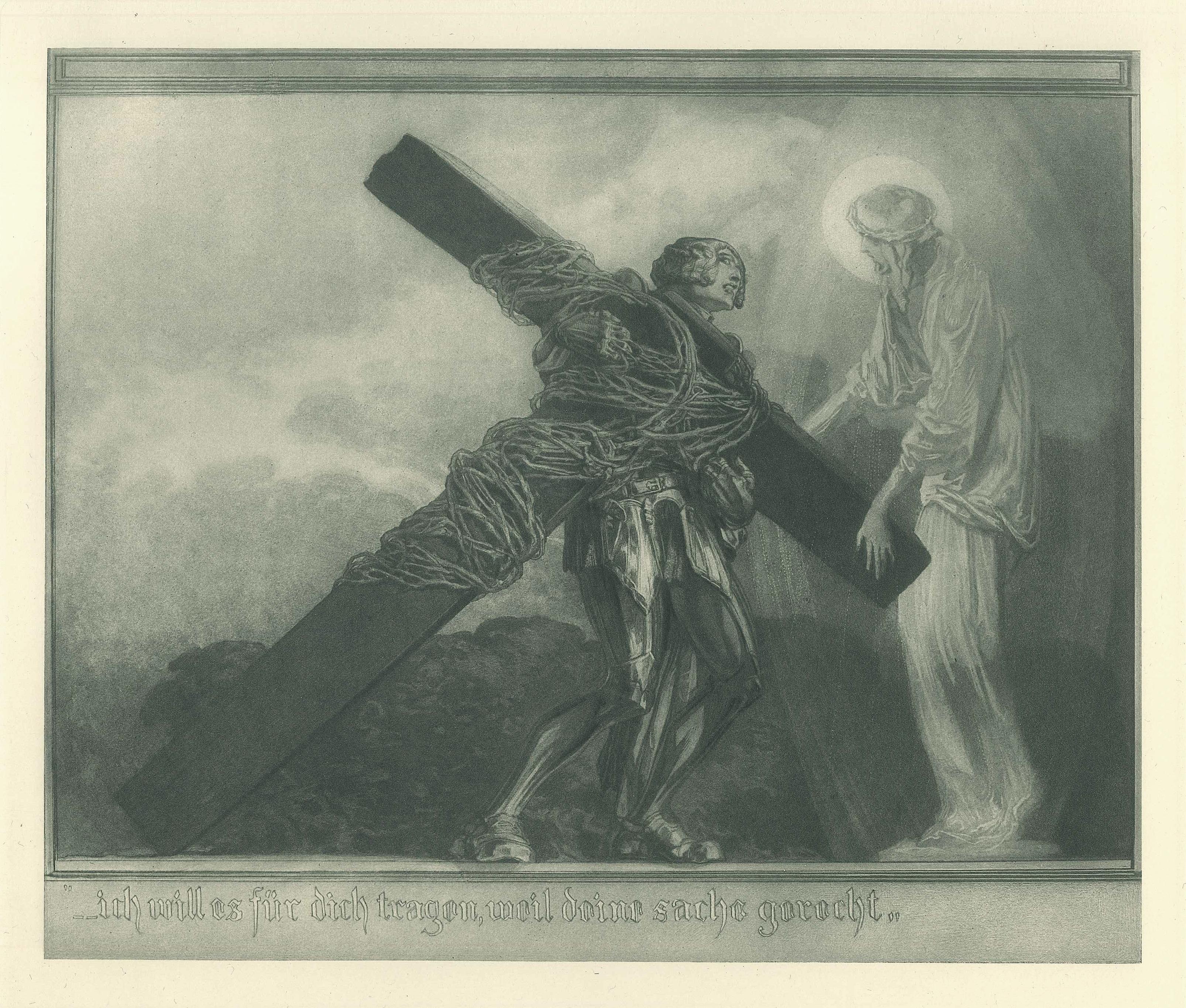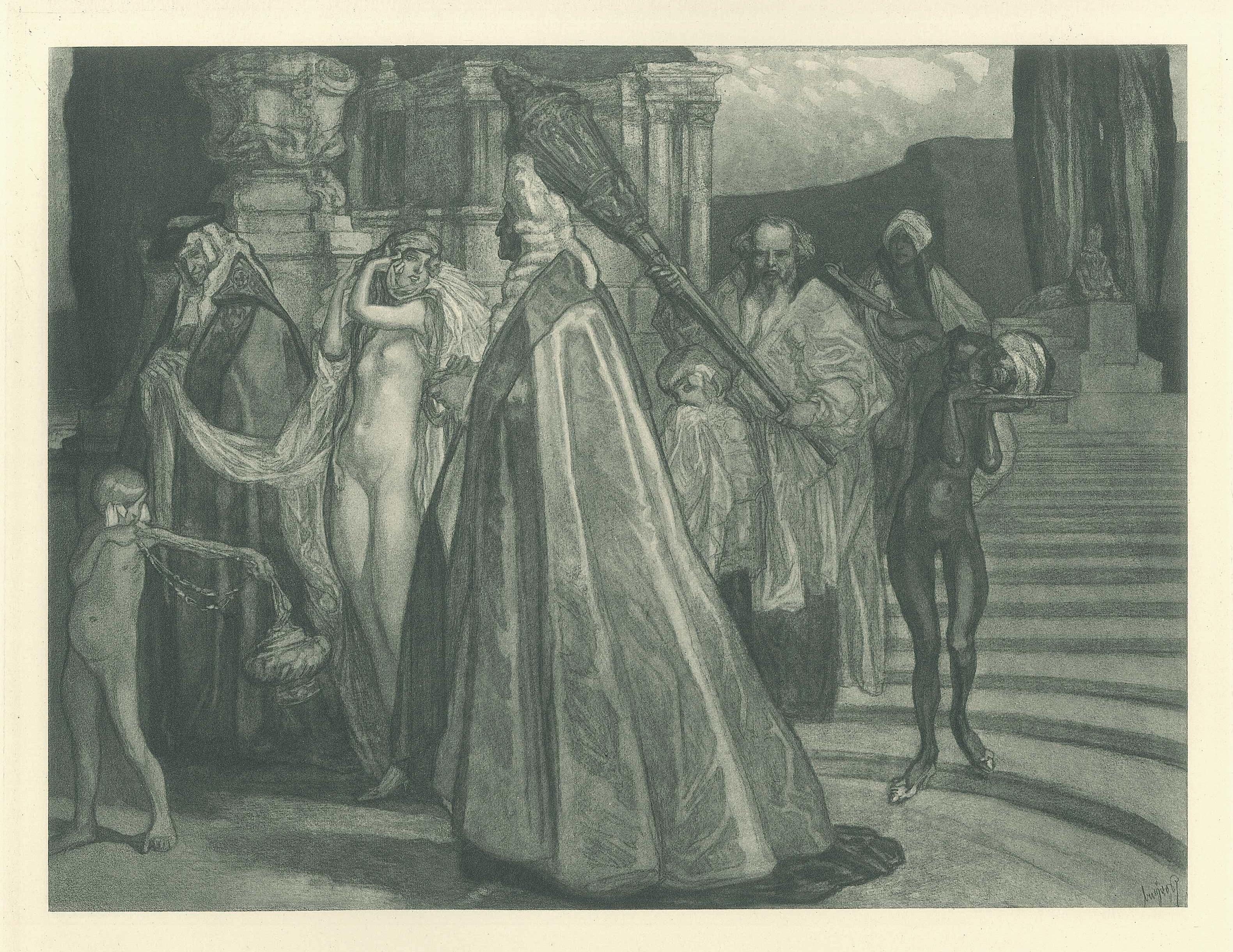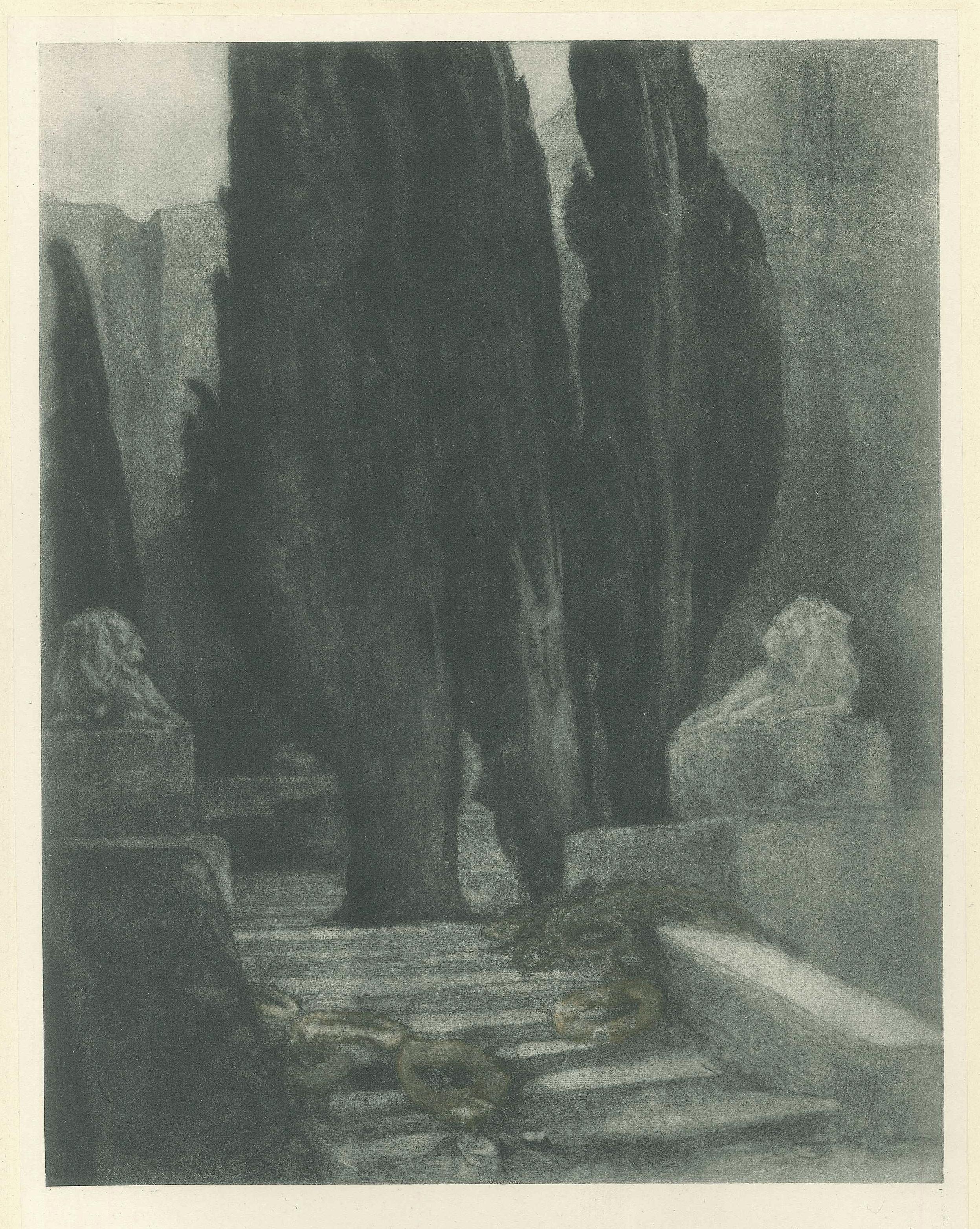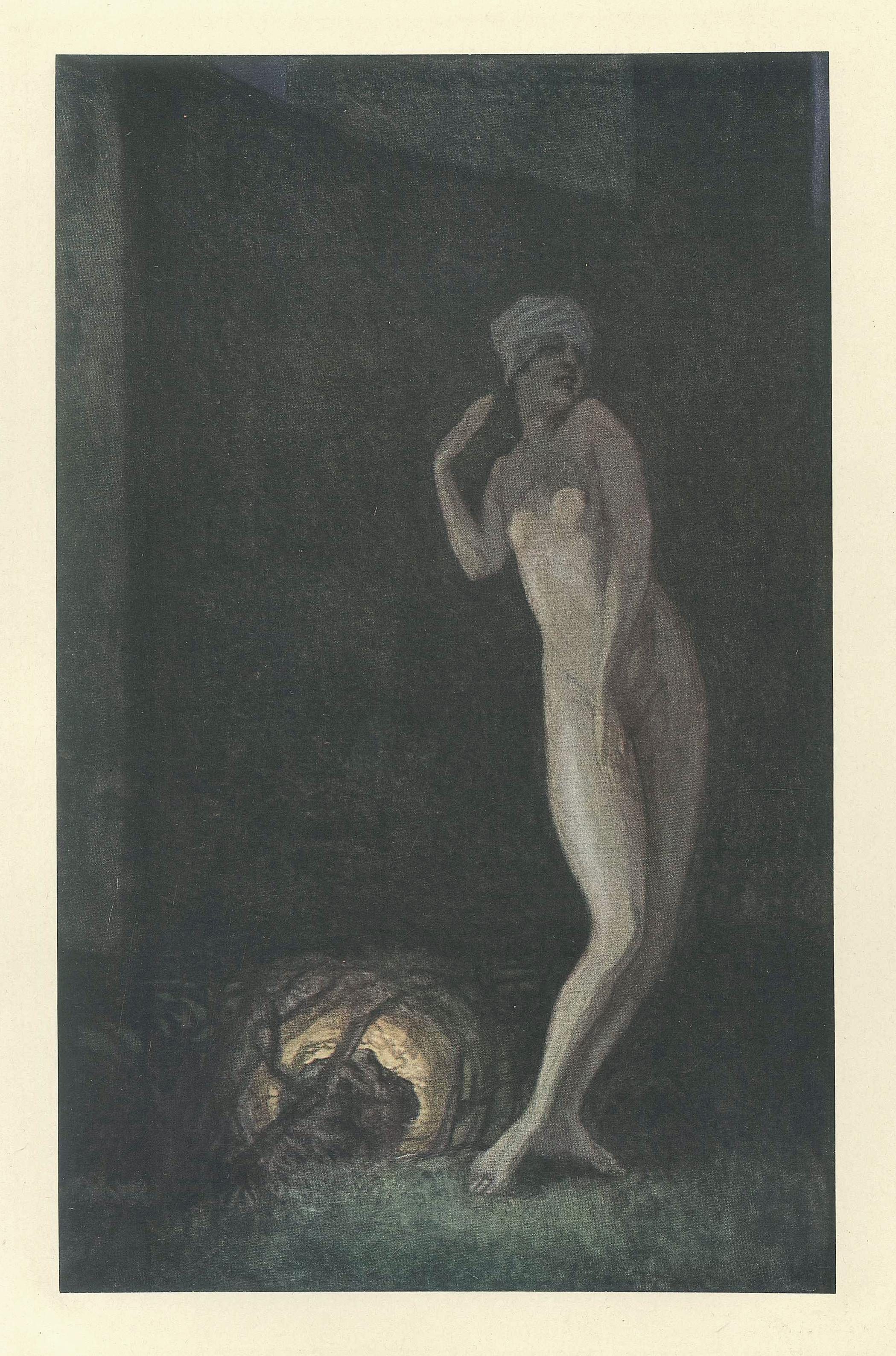Franz von StuckForellenweiher - Etching and Drypoint by Franz Von Stuck - 1890s1890s
1890s
About the Item
- Creator:Franz von Stuck (1863 - 1928)
- Creation Year:1890s
- Dimensions:Height: 20.87 in (53 cm)Width: 14.97 in (38 cm)Depth: 0.04 in (1 mm)
- Medium:
- Movement & Style:
- Period:
- Framing:Framing Options Available
- Condition:Insurance may be requested by customers as additional service, contact us for more information.
- Gallery Location:Roma, IT
- Reference Number:
Franz von Stuck
Franz von Stuck was a German artist of exceptional skills as a painter, sculptor, engraver, photographer, and draughtsman. He was born in Tettenweis, Germany, in 1863. He was a member-founder of the Munich Secession in 1893, and together with other artists, he was a forerunner of the Art Nouveau experience, called Jugendstil in Germany. Thanks to his style of formal perfection, sensuality and decadent sensitivity, he seduced the art world of half Europe. Von Stuck was particularly successful in Italy, to such an extent that he was granted a solo show at the Venice Biennial of 1909. His figurative repertory derived from classical art centaurs, fauns, nymphs drawn from antique mythology in the wake of a tradition inaugurated by Arnold Böcklin and was mediated through a fin-de-siècle sensibility towards eroticism and artfulness.
- ShippingRetrieving quote...Ships From: Grasse, France
- Return PolicyA return for this item may be initiated within 14 days of delivery.
- Ich will es für dich trage - Vintage Héliogravure by Franz von Bayros - 1921 ca.By Franz von Bayros (Choisi Le Conin)Located in Roma, ITIch will es für dich tragen is a black and white héliogravure on cream-colored cardboard realized by Choisy Le Conin, pseudonym of Franz Von Bayros (Agram, 1866 – Vienna, 1924). Fro...Category
1920s Symbolist Figurative Prints
MaterialsEngraving
- Erfüllung - Vintage Héliogravure by Franz von Bayros - 1921 ca.By Franz von Bayros (Choisi Le Conin)Located in Roma, ITErfüllung is a black and white héliogravure on cream-colored cardboard realized by Choisy Le Conin, pseudonym of Franz Von Bayros (Agram, 1866 – Vienna, 1924). From Mappe, a portfol...Category
1920s Symbolist Figurative Prints
MaterialsEngraving
- Triumph der Salome - Vintage Héliogravure by Franz von Bayros - 1921 ca.By Franz von Bayros (Choisi Le Conin)Located in Roma, ITTriumph der Salome is a black and white héliogravure on cream-colored cardboard realized by Choisy Le Conin, pseudonym of Franz Von Bayros (Agram, 1866 – Vienna, 1924). From Mappe, ...Category
1920s Symbolist Figurative Prints
MaterialsEngraving
- Tribut der Salome - Vintage Héliogravure by Franz von Bayros - 1921 ca.By Franz von Bayros (Choisi Le Conin)Located in Roma, ITTribut der Salome is a colored cliché from watercolor on cream-colored cardboard realized by Choisy Le Conin, as is remembered Franz Von Bayros (Agram, 1866 – Vienna, 1924). From Ma...Category
1920s Symbolist Figurative Prints
MaterialsEngraving
- Requiem - Vintage Héliogravure by Franz von Bayros - 1921 ca.By Franz von Bayros (Choisi Le Conin)Located in Roma, ITMit Reinen Händen is a black and white héliogravure on cream-colored cardboard realized by Choisy Le Conin, pseudonym of Franz Von Bayros (Agram, 1866 – Vienna, 1924). From Mappe, a...Category
1920s Symbolist Figurative Prints
MaterialsEngraving
- Salome Tanzt - Vintage Héliogravure by Franz von Bayros - 1921 ca.By Franz von Bayros (Choisi Le Conin)Located in Roma, ITSalome Tanzt is a colored cliché from watercolor on cream-colored cardboard realized by Choisy Le Conin, as is remembered Franz Von Bayros (Agram, 1866 – Vienna, 1924). From Mappe, ...Category
1920s Symbolist Figurative Prints
MaterialsEngraving
- Steps to the Grand Canal, St. Mark's in the distance, Venice.By Donald Shaw MacLaughlanLocated in Middletown, NYA lovely view of Venice from the water. Etching with drypoint on antique cream laid paper with a large figural watermark, signed in pencil, lower right. 14 1/4 x 11 inches (362 x 280...Category
Early 20th Century American Modern Landscape Prints
MaterialsLaid Paper, Drypoint, Etching
- I Won't Eat You, Limited edition print, Animal print, Lion, Yellow, IllustrativeLocated in Deddington, GBI Won't Eat You by Kate Boxer is a limited edition drypoint etching. This contemporary art print with gouache depicts a lion and is a humorous work of art by Kate Boxer. Kate Boxer m...Category
2010s Contemporary Landscape Prints
MaterialsDrypoint, Etching, Mixed Media, Oil Pastel, Paper
- Le Marché aux PucesBy Auguste BrouetLocated in Middletown, NYPublished in Paris by Chalcographie Louvre around 1910. Drypoint etching on buff wove paper, 7 x 11 inches (175 x 278 mm) full margins. With the "Musée Louvre Chalcographie" blind st...Category
Early 20th Century French School Landscape Prints
MaterialsHandmade Paper, Drypoint, Etching
- Low Country (South Carolina)By Elizabeth VernerLocated in Middletown, NYAn enchanting Southern landscape by the mother of the Charleston Renaissance. A native of Charleston, South Carolina, and educated under the tutelage of Thomas Anshutz at The Pennsylvania Academy of Fine Arts, O'Neill Verner was a teacher, a mother, an artist, an ardent preservationist, and a skilled autodidact. Having previously focused on painting, in the early 1920s she found herself deeply moved by printmaking as a media, and especially so by the simple, peaceful themes and tableaus she discovered in Japanese art. She embarked on a effort to teach herself Japanese printmaking techniques, and in the process, produced the charming images of every day life in Charleston and its environs that earned her recognition as a cultural icon in her day, and in more modern times, as the mother of the Charleston Renaissance, which flourished well into the 1930s. In 1923 she opened a studio in Charleston where she focused on documenting the local color and the architecture and landscape that distinguishes Charleston as one of the South's most beautiful cities, all the while applying the gentle and poetic thematic sensibilities of Japanese printmaking. O'Neill Verner soon found herself in high demand when municipalities and institutions throughout the country sought commissions from her to document the beauty of their grounds and historic buildings. She worked as far north as the campuses of Harvard and Princeton, and extensively across the South, including in Savannah, Georgia, where through sweeping commissions she was able to marry her love of southern preservation and art. O'Neill Verner was a lifelong learner, and continued a path of edification that led her to study etching at the Central School of Art in London, to travel extensively through Europe, and to visit Japan in 1937, where she studied sumi (brush and ink) painting. She was a founding member of the Charleston Etchers Club, and the Southern States Art League. Her works are represented in the permanent collections of leading museums across the American south, and in major national institutions including the Metropolitan Museum of Art, Boston's Museum of Fine Art, and the Smithsonian American Art Museum. O'Neil Verner...Category
Early 20th Century American Modern Landscape Prints
MaterialsArchival Paper, Drypoint, Etching
- The Old Smyth Gate, Charleston, South CarolinaBy Alfred HuttyLocated in Middletown, NYA view of the gateway to Simmons-Edwards House (14 Legare Street), also known as the Pineapple Gate House. Etching with drypoint on watermarked "Hand Made" laid paper, signed in pen...Category
Early 20th Century American Modern Landscape Prints
MaterialsLaid Paper, Drypoint, Etching, Handmade Paper
- BillingsgateBy James Abbott McNeill WhistlerLocated in Middletown, NYEtching printed in dark brownish black ink on cream laid paper, 6 x 8 7/8 inches (152 x 226 mm); full margins. Extremely minor and unobtrusive band of toning along the top sheet edg...Category
Mid-19th Century Impressionist Landscape Prints
MaterialsDrypoint, Laid Paper, Etching






